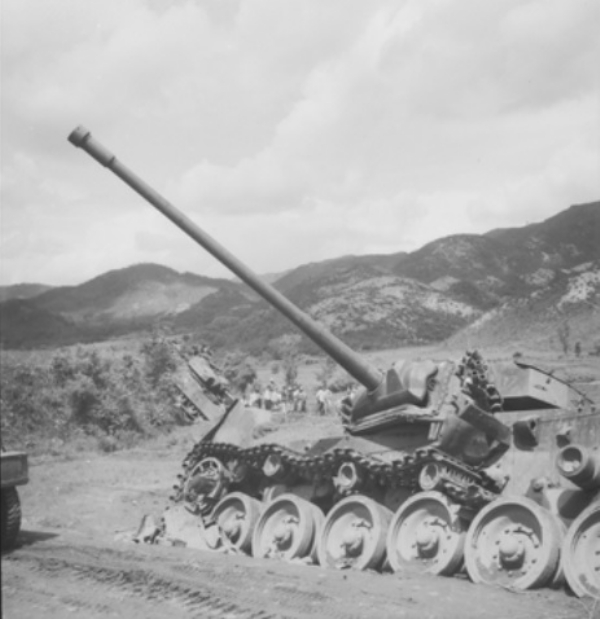

1× Jeep Driver, Private First Class, armed with 1 M3 Submachine GunĪs of 1948, each Infantry Regiment was to have its own organic Heavy Tank Company to “close with and destroy the enemy and to provide antitank protection for the regiment”.5 - M4A3(76)W HVSS Sherman (M26 in theory) 1× Platoon Sergeant, Master Sergeant, armed with 1 M1911A1 pistol.4 - M4A3(76)W HVSS Sherman (M26 in theory) 3 - M4A3(76)W HVSS Sherman (M26 in theory) 2 - M4A3(76)W HVSS Sherman (M26 in theory) 1× Platoon Leader, Lieutenant, armed with 1 M1911A1 pistol.1 - M4A3(76)W HVSS Sherman (M26 in theory) 4× Platoons (1 Officer and 25 Enlisted each) 1st Section → Tank No. 1× Food Service Apprentice (Driver), Private First Class, armed with 1 M3 Submachine Gun.2× 2nd Cooks, Corporal, armed with 1 M1/M2 Carbine.3× Cooks, Sergeant, armed with 1 M1/M2 Carbine.1× Mess Steward, Sergeant First Class , armed with 1 M1/M2 Carbine.50 caliber machine gun mounted and Bazooka on board. 6× Filler Personnel, Private, armed with 1 M1/M2 Carbine.1× Food Service Apprentice (Driver), Private, armed with 1 M3 Submachine Gun.1× Clerk, Corporal, armed with 1 M1/M2 Carbine.1× Supply Sergeant, Sergeant First Class, armed with 1 M1/M2 Carbine.1× First Sergeant, Master Sergeant, armed with 1 M1/M2 Carbine.1× Unit Administrator, Warrant Officer, armed with 1 M1/M2 Carbine. Admin, Mess & Supply Section, Company HQ (17 Enlisted + 1 WO after '49) → 2.5-ton 6×6 Cargo Truck*

1× Driver, Private First Class, armed with 1 M1/M2 Carbine.1× Vehicle Recovery Commander, Sergeant, armed with 1 M1/M2 Carbine.4× Tank Mechanic, Corporal, armed with 1 M1/M2 Carbine.1× Tank Mechanic (Driver), Corporal, armed with 1 M3 Submachine Gun.1× Tank Mechanic, Sergeant, armed with 1 M1/M2 Carbine.1× Automotive Mechanic, Private First Class, armed with 1 M1/M2 Carbine.1× Artillery-Armorer Mechanic, Corporal, armed with 1 M1/M2 Carbine.1× Motor Sergeant, Master Sergeant, armed with 1 M1/M2 Carbine. → M39 Armored Utility Vehicle or M3A1 Half-Track 1× Radio Repairman (Jeep Driver), Corporal, armed with 1 M3 Submachine Gun.1× Executive Officer, Lieutenant, armed with 1 M1/M2 Carbine. Maintenance Section, Company HQ (1 Officer and 13 Enlisted) → 1/4-ton Jeep* * One M8 grenade launcher on board for mounting to a carbine. 1× Bugler (Jeep Driver), Private , armed with 1 M3 Submachine Gun.1× Liaison Agent, Corporal, armed with 1 M1 Carbine.1× Communication Chief, Sergeant, armed with 1 M1/M2 Carbine.1× Tank Commander, Sergeant First Class, armed with 1 M1911A1 pistol. → M4A3(76)W HVSS Sherman (M45 in theory) 1× Cannoneer (Loader), Private First Class, armed with 1 M1911A1 pistol and 1 M3 Submachine Gun.1× Bow Gunner, Corporal, armed with 1 M1911A1 pistol and 1 M1/M2 Carbine.1× Driver, Sergeant, armed with 1 M1911A1 pistol.1× Gunner, Sergeant, armed with 1 M1911A1 pistol.1× Company Commander, Captain, armed with 1 M1911A1 pistol. Headquarters Section, Company HQ (1 Officer and 12 Enlisted) → M4A3(76)W HVSS Sherman (M45 in theory) Ranks that were active during the Korean War post-1950 are displayed, with the 1948-50 WWII-era ranks displayed in brackets if different. Personnel*: 6 Officers, 1 Warrant Officer (only after Dec 1949) and 142 Enlisted.
#Korean war tank battles software#
Like our content? Consider supporting us on Patreon to help with web host and software costs! The regiment could also be augmented with a small Light Aviation Section consisting of two liaison fixed wing aircraft and a helicopter. The next level up was the Infantry Regiment, which consisted of a Regimental HQ & HQ Company, Service Company, Medical Company, Tank Company (this), Heavy Mortar Company, and 3 Infantry Battalions. The company consisted of a Company Headquarters (further subdivided into the Headquarters Section Admin, Mess & Supply Section and Maintenance Section) and 4 Tank Platoons. The only exceptions were minor changes made to the Company HQ’s Maintenance Section and Admin, Mess & Supply Section in 19. Most aspects of this organization remained broadly the same until as late as 1957 when the Pentomic structure was brought online and infantry regimental tank companies were done away with. These were tank companies organic to Infantry Regiments intended to provide support to infantry operations and provide the regiment anti-armor protection. Army’s Infantry Regiment active from April 1948 to May 1952.

The following was the organization of the Korean War-era Heavy Tank Company of the U.S.


 0 kommentar(er)
0 kommentar(er)
